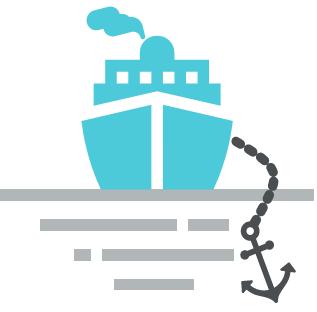Use the search below to find question.
Amount of questions: 68 .
Right answers marked with this sign
What is a «BAREBOAT CHARTER »?
When can an owner place a «LIEN » on a cargo?
What is «FREIGHT »?
What does the term «RE-DELIVERY » mean with reference to charters?
same good order » as delivered, fair wear and tear excepted.
What should the correct working relationship between the Master and the Charterer be?
When does «Laytime » start on a voyage charter?
How should the master treat cargo claim surveyors who are «LOOKING FOR EVIDENCE? »
When can a vessel be declared as «OFF-HIRE »?
What is a «NOTICE OF READINESS »?
When is the «CHARTER HIRE » of a time chartered vessel paid?
days , in advance, after deduction of the broker’s commission.
In the voyage charter party what «deviations » are usually considered as justifiable?
What is the principle of General Average?
GA is that which has been sacrificed for the benefit of all, shall be made good by the contribution of all.
What are the York-Antwerp rules?
What is a «LETTER OF PROTEST »?
What does «STCW » mean?
When is a ship deemed to be «SEAWORTHY » for charter purposes?
Seaworthy » when she is reasonably fit in all respects, to encounter the ordinary perils of the sea, of the adventure insured.
What is a «DIRTY BILL OF LADING »?
What does «FAS » mean in the context of cargo?
What does «FOB » mean in the context of cargo?
What does «C & F » mean in the context of cargo?
What does «CIF » mean in the context of cargo?
What does «CIP » mean in the context of cargoes?
What is a «BILL OF LADING? »
What does the term «DISPATCH » mean with reference to cargoes?
Reward » or dispatch, to the charterer.
What is a «LETTER OF INDEMNITY » presented with a Bill of Lading?
clean bills of lading » even though he knows the goods are defective. The master should not accept it.
What is «DEMURRAGE »?
What are the «HAMBURG RULES »?
What is a «CHARTER »?
What are «Laydays? »?
What is «Laytime? »?
Notice of Readiness ».
What is the «CANCELLATION DATE » with reference to charters?
What are an insurer’s «LIABILITIES AND EXCLUSIONS » in the context of marine insurance?
What is the prime function of a Bill of Lading?
In relation to the ISM code, what is the function of the «DESIGNATED PERSON »?
SMS systems are in place.
What is a «SECOND REGISTER »?
What are seen as the benefits of «FOC » registration?
What does «ISM » mean?
What are the objectives of the «ISM » code?
FOC & 2nd registers.
What is «MARPOL »?
When should the master send «A LETTER OF PROTEST »?
What is considered as «Negligence » on the part of the master, in the context of marine insurance?
first name » relationship with his Officers, thereby failing to establish a responsible attitude from them.
What do the letters «IMO » stand for?
What is an «OUTWARD CLEARANCE », and how is it obtained?
What penalties can be imposed for breaching the «COLLISION REGULATIONS? »
COLREG CONVENTION OF 1972 ».
What does «OPA 90 » mean?
What constitutes an «ACT OF SALVAGE »?
What is a Lloyds Open Form 95 (LOF 95 )?
What constitutes a «Port of Refuge? »?
What is a «SAFETY MANAGEMENT SYSTEM » designed to accomplish?
SMS is just another creation of bureaucrats who think they know more than experienced owners. The latter can decide for themselves to use it or not.
In the event of a «Hull and Machinery » claim, who is appointed to investigate, and report?
When is a vessel considered to be a «TOTAL LOSS? »
What is a «DEDUCTIBLE » in the context of marine insurance?
What perils are normally excluded from hull and machinery cover?
What does «P & I » mean in the context of maritime business?
What are the functions of the «P & I » clubs?
Which insurance coverage protects an owner against «COLLISION LIABILITY »?
P & I club.
What does «FOC » mean?
What is the function of an «AVERAGE ADJUSTER? ?»
What is «INTERNATIONAL MARITIME LAW? »
P & I clubs and other insurers when settling claims.
What documents and information will be required from a ship when filing an insurance claim?
Utmost good faith ».
What is the extent of a «P & I » club’s cover?
P & I club cover is generally limited to personal injury and death claims only. Very limited cover may be incl. for cargo damage & pollution.
P & I club cover is very selective and only available to those owners considered prudent. Owners with poor records are not accepted.
What sort of personal injury cover do «P & I » clubs provide?
What does «SOLAS » stand for?
What does «ILO » stand for?
What sort of agreement exists between the master and the crew?
How do «P & I » clubs provide advice to owners at far distant ports?
What does «CPT » mean in the context of cargo?
What does «DDP » mean in the context of cargo?

